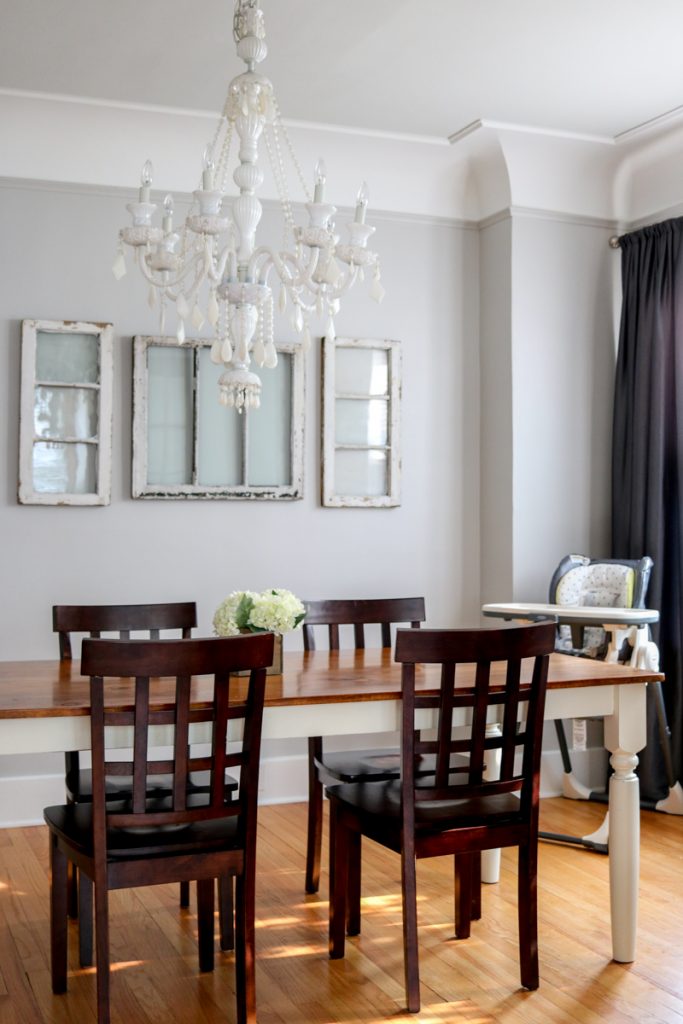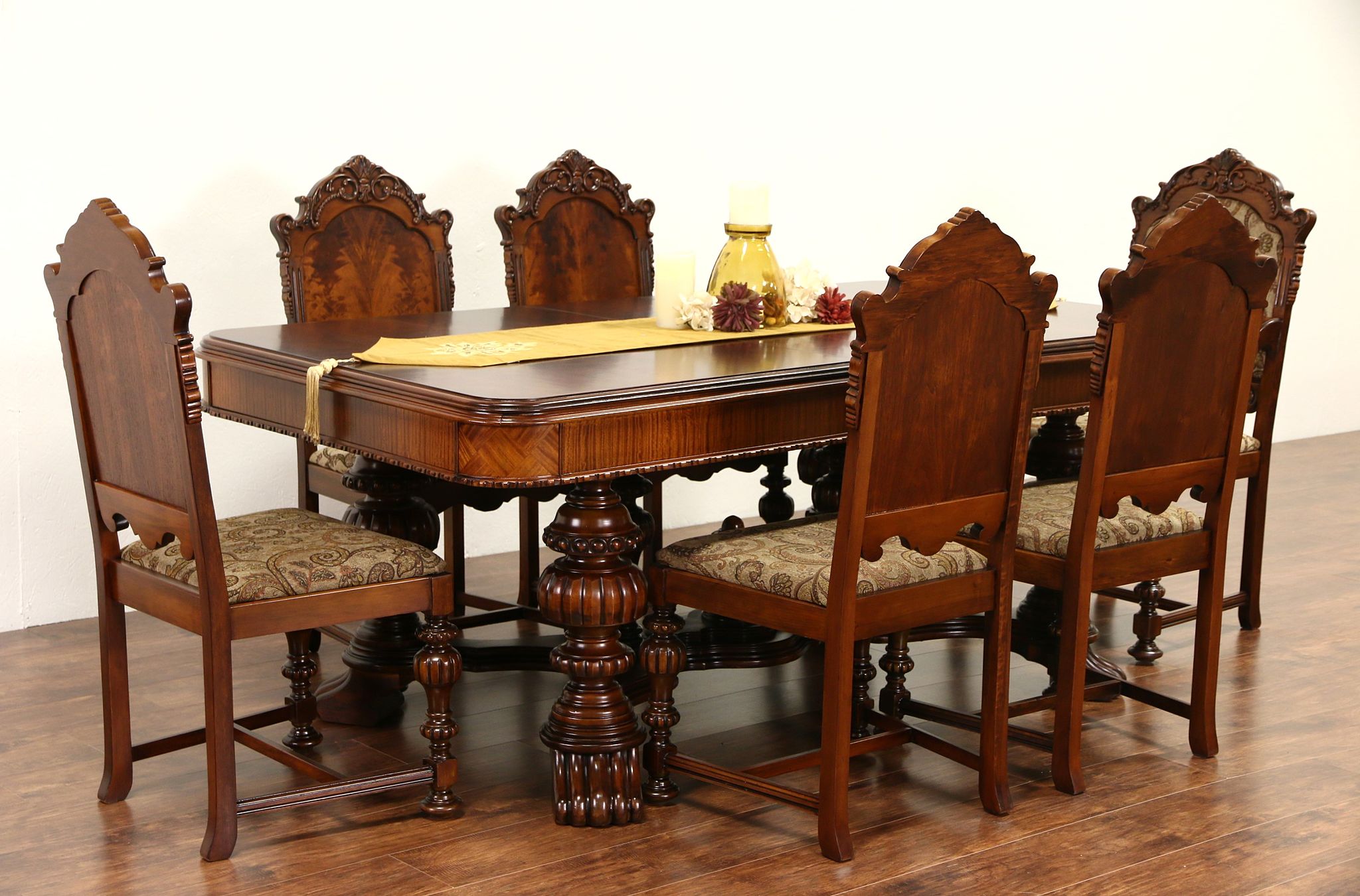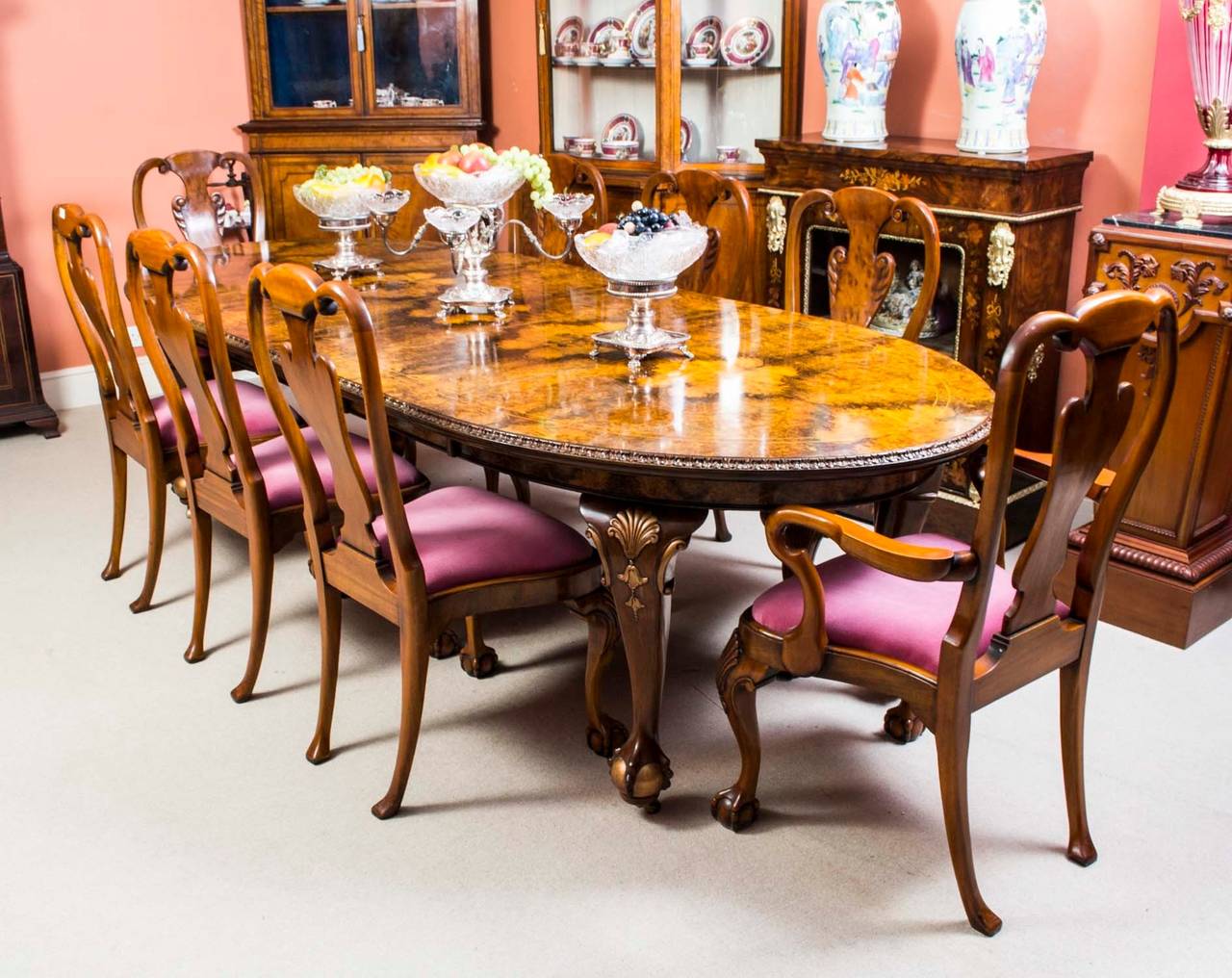The 1920s was a time of elegance and opulence, and this was reflected in the design and decor of dining rooms. If you're looking to create a dining room that exudes the glamour and sophistication of the roaring twenties, here are some ideas to inspire you. Art Deco Style: The 1920s was the heyday of the Art Deco movement, known for its bold geometric shapes and luxurious materials. Embrace this style in your dining room with a statement chandelier, mirrored surfaces, and sleek furniture adorned with Art Deco-inspired patterns. Rich Colors: In the 1920s, color palettes were all about richness and depth. Think deep blues, emerald greens, and rich burgundies. These colors can be incorporated into your dining room through the use of velvet upholstery on dining chairs or a dramatic wallpaper featuring these shades. Gold Accents: Gold was a popular metal during the 1920s and is a perfect way to add a touch of glamour to your dining room. Incorporate gold accents through lighting fixtures, tableware, and even on the edges of your dining table. Glamorous Lighting: Lighting played a crucial role in 1920s dining room design. A dramatic chandelier was often the centerpiece of the room, creating a sense of grandeur. Consider a chandelier with cascading crystals or a sleek and modern design to add a touch of 1920s glamour to your dining space. Mirrored Surfaces: Mirrored surfaces were a staple in 1920s design. They add a touch of luxury and reflect light, making the room appear larger and more spacious. Incorporate mirrored surfaces in your dining room through a mirrored buffet or a statement mirror on the wall.1920s Dining Room Ideas
The 1920s was a time of prosperity and change, and this was reflected in the design and decor of living rooms. If you're looking to create a living room that captures the essence of the roaring twenties, here are some decor ideas to inspire you. Art Deco Accents: The Art Deco movement of the 1920s was all about luxury and glamour. Incorporate Art Deco accents in your living room through geometric patterns, metallic finishes, and bold colors. Velvet Upholstery: Velvet was a popular fabric during the 1920s, adding a touch of luxury to any space. Incorporate velvet upholstery in your living room through a velvet sofa or armchair, or even through throw pillows and blankets. Rich Textures: To add depth and interest to your living room, incorporate rich textures such as faux fur, silk, and velvet. These textures add a touch of luxury and create a cozy and inviting atmosphere. Statement Lighting: In the 1920s, lighting was not just functional but also a statement piece in itself. Incorporate dramatic lighting fixtures in your living room, such as a chandelier or a unique floor lamp, to add a touch of 1920s glamour to your space. Ornate Details: The 1920s was a time of ornate and intricate details. Incorporate ornate details in your living room through decorative molding, patterned rugs, and intricate artwork. These details add a touch of elegance and sophistication to your space.1920s Living Room Decor
The 1920s was a time of lavish and opulent dining rooms, and the furniture was no exception. If you're looking to create a dining room that captures the essence of the roaring twenties, here are some furniture ideas to inspire you. Round Dining Table: In the 1920s, dining tables were often round, creating a sense of intimacy and encouraging conversation among guests. Consider a round dining table with a rich wood finish or a sleek marble top for a touch of 1920s elegance. Upholstered Dining Chairs: Upholstered dining chairs were a popular choice in the 1920s, adding a touch of luxury and comfort to the dining room. Choose chairs with velvet or silk upholstery in rich colors to add a touch of 1920s glamour to your dining space. Sideboard or Buffet: In the 1920s, a sideboard or buffet was a staple in most dining rooms. These pieces not only provided extra storage but also added a touch of elegance to the space. Choose a sideboard or buffet with intricate details and a rich wood finish for a touch of 1920s sophistication. Bar Cart: The prohibition era of the 1920s meant that many households had a bar cart in their dining room. Bring a touch of 1920s decadence to your dining room with a bar cart featuring a sleek and stylish design. Statement Chandelier: As mentioned before, lighting was an essential element in 1920s dining room design. Choose a statement chandelier with cascading crystals or an intricate design to add a touch of glamour and opulence to your dining space.1920s Dining Room Furniture
The 1920s was a time of change and innovation, and this was evident in the design of living rooms. If you're looking to create a living room that captures the essence of the roaring twenties, here are some design ideas to inspire you. Open Floor Plan: In the 1920s, open floor plans were becoming more popular, allowing for a more spacious and fluid living space. Consider knocking down walls to create an open living room that seamlessly flows into the dining area. Geometric Patterns: Geometric patterns were a prominent feature in 1920s design, reflecting the rise of the Art Deco movement. Incorporate geometric patterns in your living room through wallpaper, throw pillows, or a statement rug. Mix of Modern and Traditional: The 1920s was a time of transition between traditional and modern design. Embrace this by incorporating both modern and traditional elements in your living room, such as a sleek and modern sofa paired with a traditional patterned rug. Neutral Color Palette: While rich colors were popular during the 1920s, some homeowners opted for a more subdued and neutral color palette. Choose neutral shades such as beige, gray, and cream for your living room walls and furniture, and add pops of color through accents and accessories. Incorporate Nature: The 1920s saw a rise in the popularity of nature-inspired elements in interior design. Incorporate nature-inspired elements in your living room, such as floral patterns, natural textures, and houseplants, to create a sense of tranquility and peace in your space.1920s Living Room Design
The dining table is the centerpiece of any dining room, and in the 1920s, it was no different. If you're looking to create a dining room that captures the essence of the roaring twenties, here are some ideas for your dining table. Round Table: As mentioned before, round dining tables were popular in the 1920s. Not only do they create a sense of intimacy, but they also allow for easy conversation among guests. Choose a round dining table with a rich wood finish or a sleek marble top for a touch of 1920s elegance. Extendable Table: Many homeowners in the 1920s hosted lavish dinner parties and needed a dining table that could accommodate a large number of guests. Consider an extendable dining table with a removable leaf to easily adjust the size of your table for different occasions. Art Deco Details: The Art Deco movement of the 1920s was all about bold geometric shapes and luxurious materials. Incorporate Art Deco details in your dining table through intricate patterns, metallic finishes, and sleek lines. Statement Centerpiece: A centerpiece on the dining table was a must-have in the 1920s. Choose a statement centerpiece such as a large floral arrangement or a crystal vase filled with fresh blooms to add a touch of elegance and opulence to your dining table. Tableware: In the 1920s, table settings were just as important as the food being served. Choose ornate and luxurious tableware such as delicate china, silver cutlery, and crystal glasses to add a touch of 1920s sophistication to your dining table.1920s Dining Room Table
The 1920s was a time of change and innovation, and this was reflected in the furniture design of living rooms. If you're looking to create a living room that captures the essence of the roaring twenties, here are some furniture ideas to inspire you. Art Deco Sofa: The Art Deco movement of the 1920s was all about luxury and glamour. Embrace this style in your living room with an Art Deco sofa featuring clean lines, geometric shapes, and luxurious materials such as velvet or leather. Club Chairs: Club chairs were a popular choice in 1920s living rooms, known for their comfortable and inviting design. Choose club chairs with deep seats and soft upholstery for a touch of 1920s elegance and comfort in your living room. Coffee Table with Storage: In the 1920s, homeowners were looking for ways to declutter their living spaces and make them appear more organized. Choose a coffee table with built-in storage to add a touch of functionality and organization to your living room. Bar Cart: As mentioned before, the prohibition era of the 1920s meant that many households had a bar cart in their living room. Bring a touch of 1920s decadence to your living room with a bar cart featuring a sleek and stylish design. Statement Rug: Rugs were an essential element in 1920s living room design, adding warmth and texture to the space. Choose a statement rug with a bold pattern or rich colors to add a touch of 1920s style to your living room.1920s Living Room Furniture
A chandelier is often the centerpiece of a dining room, and in the 1920s, it was a crucial element in creating a glamorous and opulent space. If you're looking for a chandelier that captures the essence of the roaring twenties, here are some ideas to inspire you. Cascading Crystals: In the 1920s, chandeliers with cascading crystals were a popular choice, adding a touch of luxury and elegance to the dining room. Choose a cascading crystal chandelier with a sleek and modern design for a touch of 1920s glamour. Art Deco Design: The Art Deco movement of the 1920s was known for its bold geometric shapes and luxurious materials. Incorporate Art Deco design in your chandelier with sleek lines, metallic finishes, and intricate patterns. Sleek and Modern: While the 1920s was a time of opulence, some homeowners opted for a more modern and streamlined look in their dining rooms. Choose a sleek and modern chandelier with clean lines and minimalistic design for a touch of 1920s sophistication. Unique Shape: In the 1920s, chandeliers came in all shapes and sizes, from traditional round designs to more unique and abstract shapes. Choose a chandelier with a unique shape to add a touch of personality and interest to your dining room. Gold Accents: Gold was a popular metal in the 1920s and is a perfect way to add a touch of glamour to your dining room. Choose a gold accented chandelier to add a touch of luxury and sophistication to your space.1920s Dining Room Chandelier
The 1920s was a time of prosperity and change, and this was reflected in the color palettes used in living rooms. If you're looking to create a living room that captures the essence of the roaring twenties, here are some color ideas to inspire you.1920s Living Room Colors
The Dining Room and Living Room: The Heart of 1920s House Design

The 1920s was a decade of transformation in house design, particularly in the dining and living rooms. With the rise of modernism and the influence of the Art Deco movement, these two spaces became the center of social activity and reflected the changing attitudes of the era.
 The dining room and living room were seen as the heart of the home during the 1920s. This was a time when people were beginning to embrace a more relaxed and informal lifestyle, and these spaces were designed to reflect that.
Functionality
was key, with a focus on creating comfortable and inviting spaces for entertaining guests and spending quality time with family.
In terms of
color palette
, the 1920s saw a shift away from the dark and heavy Victorian styles of the past. Lighter and brighter colors were favored, with pastel shades and bold pops of color being popular choices. The use of geometric patterns and bold geometric shapes also became prevalent, in line with the influence of Art Deco.
Furniture
in the dining and living rooms also underwent a transformation in the 1920s. The heavy and ornate styles of the past were replaced with sleeker and more streamlined designs. This was a time when furniture was becoming more functional and practical, with a focus on comfort and simplicity. Popular pieces included armchairs, sofas, and dining tables with clean lines and minimal ornamentation.
In addition to the changing styles and designs, the 1920s also saw a shift in the
social dynamics
of the dining and living rooms. With the rise of the middle class and the introduction of labor-saving devices, entertaining became more accessible to the masses. As a result, these spaces became a hub for social gatherings and a way for people to showcase their wealth and status.
In conclusion, the dining room and living room were the heart of 1920s house design, representing the changing attitudes and lifestyles of the era. From the use of light and bright colors to the shift towards more functional and practical furniture, these spaces were a reflection of the modern and progressive mindset of the time. So next time you step into a dining or living room from the 1920s, take a moment to appreciate the history and evolution of these important spaces in house design.
The dining room and living room were seen as the heart of the home during the 1920s. This was a time when people were beginning to embrace a more relaxed and informal lifestyle, and these spaces were designed to reflect that.
Functionality
was key, with a focus on creating comfortable and inviting spaces for entertaining guests and spending quality time with family.
In terms of
color palette
, the 1920s saw a shift away from the dark and heavy Victorian styles of the past. Lighter and brighter colors were favored, with pastel shades and bold pops of color being popular choices. The use of geometric patterns and bold geometric shapes also became prevalent, in line with the influence of Art Deco.
Furniture
in the dining and living rooms also underwent a transformation in the 1920s. The heavy and ornate styles of the past were replaced with sleeker and more streamlined designs. This was a time when furniture was becoming more functional and practical, with a focus on comfort and simplicity. Popular pieces included armchairs, sofas, and dining tables with clean lines and minimal ornamentation.
In addition to the changing styles and designs, the 1920s also saw a shift in the
social dynamics
of the dining and living rooms. With the rise of the middle class and the introduction of labor-saving devices, entertaining became more accessible to the masses. As a result, these spaces became a hub for social gatherings and a way for people to showcase their wealth and status.
In conclusion, the dining room and living room were the heart of 1920s house design, representing the changing attitudes and lifestyles of the era. From the use of light and bright colors to the shift towards more functional and practical furniture, these spaces were a reflection of the modern and progressive mindset of the time. So next time you step into a dining or living room from the 1920s, take a moment to appreciate the history and evolution of these important spaces in house design.





































































